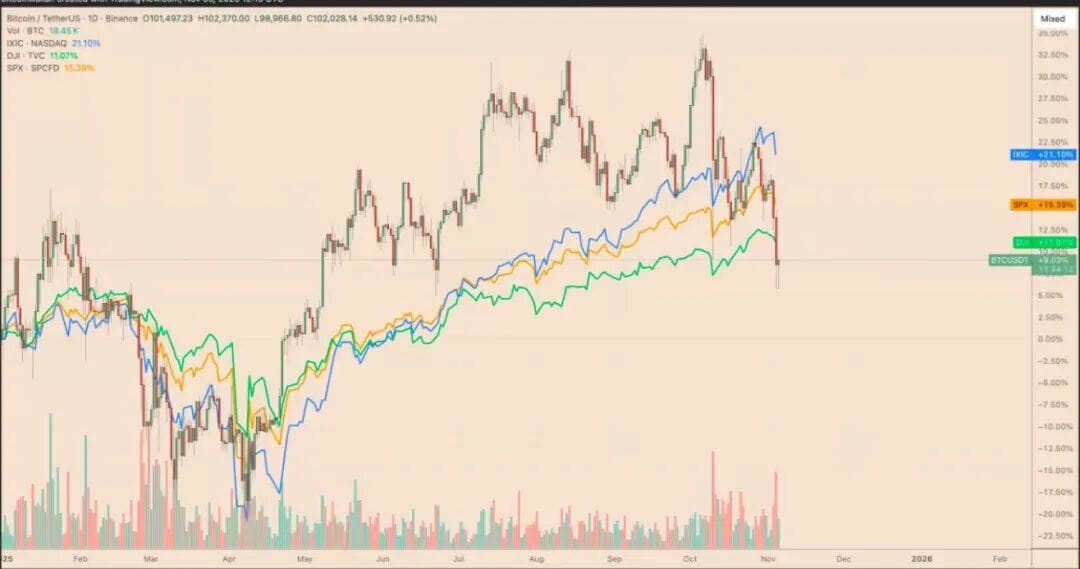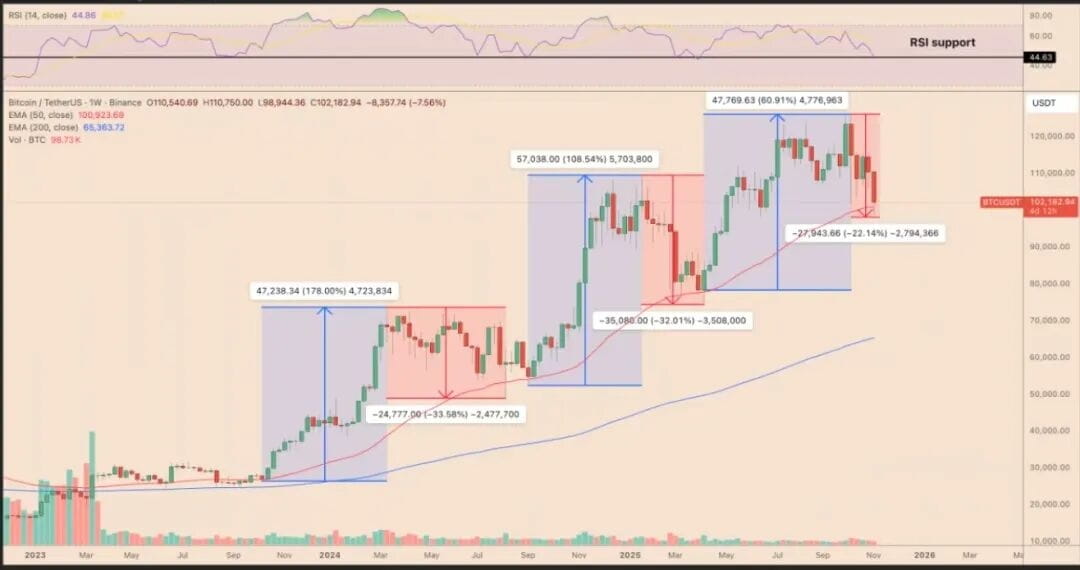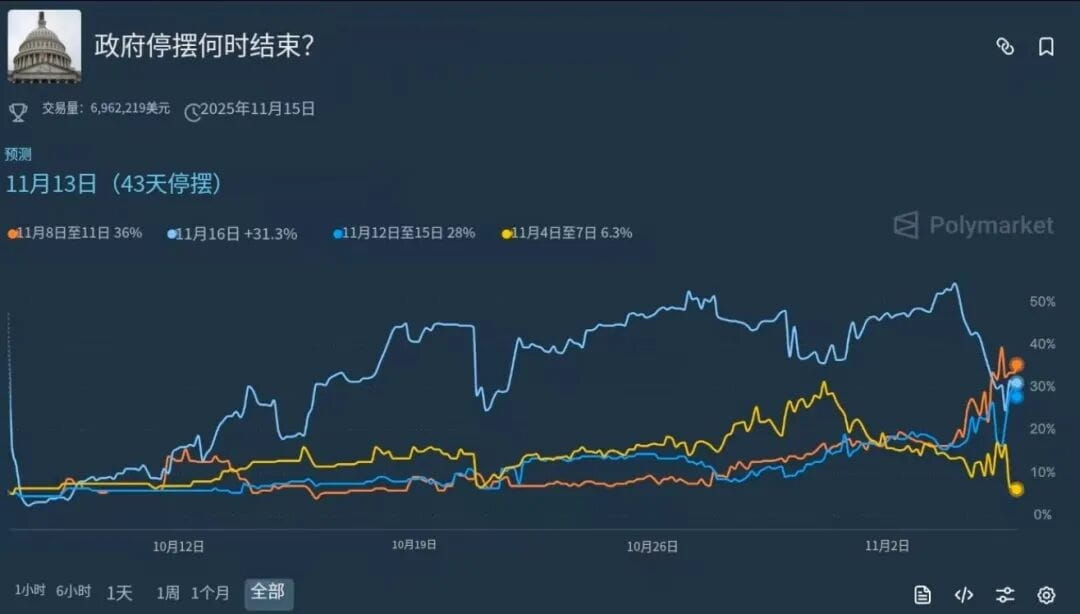In the past week, Bitcoin (BTC) has come under pressure again, falling over 8% and breaking below the $100,000 mark for the first time since June of this year. On-chain data shows that long-term holders have sold approximately $45 billion worth of BTC during this round of correction, exacerbating market selling pressure.

This decline is not an isolated event. With AI concept stocks plummeting, the overall market risk appetite has decreased, and risk assets have generally faced a correction. According to The Kobeissei Letter data, Bitcoin has seen a cumulative correction of about 20% since reaching an all-time high on October 6, officially entering a technical bear market range.
However, some technical and liquidity signals still indicate that Bitcoin may have the opportunity to stop falling and rebound at key support levels.
1. BTC must hold the key support at the 200-week EMA
From a technical perspective, Bitcoin is currently still operating above the 200-week Exponential Moving Average (EMA), which is currently around $100,950 and has been regarded as an important lifeline for the long-term trend since the end of 2023.

Looking back, whenever BTC retraces to this moving average after a significant rise, it has received strong support and risen again, so this technical position is seen by the market as a signal of structural bottom.
Currently, the BTC/USD trading pair has retraced about 22%, just defending within the historical volatility support range. Meanwhile, the weekly RSI (Relative Strength Index) remains around 45, which is a typical range for strong reversals.
As long as BTC stays above the key lines of the 200-week EMA and RSI, the overall bullish structure remains intact; conversely, if both are lost, it means the market may enter a deeper bear market adjustment.
2. 'Stealth QE' may become a liquidity turning point
Former BitMEX CEO Arthur Hayes pointed out in his latest analysis that the Federal Reserve may be forced to restart 'Stealth QE', which could become the liquidity trigger for a new round of Bitcoin increases.
According to the U.S. Treasury's Debt Management Office (DMO) Q3 2025 report, the U.S. fiscal deficit is approaching $2 trillion/year, primarily financed through the issuance of government bonds.
However, traditional buyers - such as foreign central banks and U.S. residents - have limited absorption capacity, with the remaining supply primarily taken up by hedge funds.
These funds rely on the overnight repo market to obtain financing. When cash supply is tight, the Federal Reserve's Standing Repo Facility (SRF) intervenes to provide liquidity, thereby indirectly expanding the balance sheet.
Hayes pointed out that this mechanism, although not officially called QE, is essentially still 'printing money', injecting new dollar liquidity into the market. He believes that as the fiscal deficit continues to expand, the use of the SRF will increase in frequency, secretly pushing up asset prices.
He bluntly stated: "If the Fed's balance sheet continues to expand, it means liquidity is increasing - ultimately benefiting Bitcoin and other risk assets."
3. With the U.S. shutdown unresolved, market rebound still needs to wait
However, Hayes also warned that until the U.S. government shutdown issue is resolved, overall market volatility will remain high, making it difficult for risk assets to sustain a rebound.

Current forecasts show that the market still maintains some confidence in a quick resolution of the shutdown.
On the Polymarket platform, the proportion of bets on 'the shutdown ending between November 8 and November 11' has surged from 22% last week to 36%;
The probability of reaching an agreement during the period of 'November 12 to 15' has also risen from 17% to 28%.
Meanwhile, the U.S. Treasury continues to issue government bonds, withdrawing liquidity from the market. Its General Account (TGA) is currently about $150 billion above the target of $850 billion, and this portion of funds has not yet flowed back into the economic system.
Hayes believes that many traders may misinterpret this period of stagnation as a 'market top', but in fact, once fiscal spending resumes and liquidity returns, it will usher in the next round of upward cycles.
He concluded: "There are only two states for the system - printing money or withdrawing liquidity. Right now, it is indeed the latter, but this state will not last long."
In conclusion:
Overall, whether Bitcoin can hold above the 200-week EMA (around $100,000) has become a key short-term issue.
As long as support holds and RSI does not fall below the baseline, the market structure still retains upward potential.
Once the U.S. government shutdown is lifted and the effects of the Fed's stealth QE become apparent, BTC may welcome a new wave of liquidity-driven rebound.

